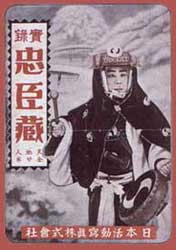 Among the very earliest samurai films was a silent short The Loyal Forty-seven Ronin (Chushingura, 1907) directed by Ryo Konishi. It alas does not survive, but its date shows how long this material has attracted filmmakers. Among the very earliest samurai films was a silent short The Loyal Forty-seven Ronin (Chushingura, 1907) directed by Ryo Konishi. It alas does not survive, but its date shows how long this material has attracted filmmakers.
Matsunosuke no Chushingura (Nijo/Yokoda Company, 1910) starring Onoe Matsunosuke is the oldest surviving version.
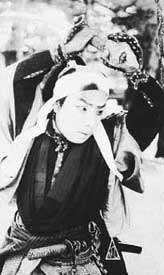 Indeed this is the oldest surviving Japanese film bar none. The existing print has all but four of the original 42 scenes. Indeed this is the oldest surviving Japanese film bar none. The existing print has all but four of the original 42 scenes.
It's really just Onoe Matsunosuke's Kabuki theater troupe performance filmed scene for scene. A static camera captures the action in one- to two-minute shots, no script required.
He was strongly identified with Chushingura among filmgoers of the era, having starred in many other versions throughout the 'teens & 'twenties (1912, 1913, 1914, 1915, 1916, 1917, 1921, 1926), sometimes more than once a year, & ranging from short films to feature lengths.
The vast majority are lost to us today, but from what remains of Onoe's work, he continued to do kabuki stances & styles to the bitter end, even as cinema changed & shifted around him.
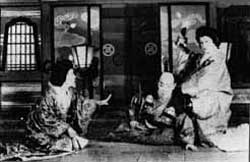 Reproduced here is a film still of Onoe in a sword posture, exceedingly attractive, in the title role of a lost film about the brave forty-seven from the same year as the surviving film, Horibe Yasubei (Yokoto Shokei Co., 1910). Reproduced here is a film still of Onoe in a sword posture, exceedingly attractive, in the title role of a lost film about the brave forty-seven from the same year as the surviving film, Horibe Yasubei (Yokoto Shokei Co., 1910).
In the next still, a seated scene from his 1910 Chushingura, we see Onoe as Oichi, leader of the loyal forty-seven ronin, pretending to be a drunken wastrel & layabout to fool the authorities. In this version his men are also losing faith due to his behavior.
This stagey pictoriality can still be detected even in more advanced & realistic film versions, as it is derived not only from kabuki plays but from ukiyo block prints which have always been an enormous influence on the look of the story.
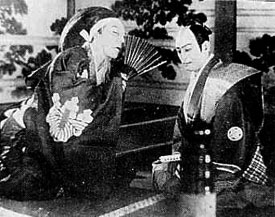 Before looking closely at the 1959 version starring Chiezo Kataoka in the signal role of Oishi, I want to address most closely, in Part I of this essay, Chiezo's presence in earlier versions. Before looking closely at the 1959 version starring Chiezo Kataoka in the signal role of Oishi, I want to address most closely, in Part I of this essay, Chiezo's presence in earlier versions.
Chiezo had been one of the great chambara film stars in his youth, when he was by turns lively & smoldering on the screen.
He played the doomed young Lord Asano in this two-part Chushingura (1934). It co-starred Okochi Denjiro in the role of Oishi, & was directed by the great Daisuke Ito & fellow chambara pioneer Itami Mansaku.
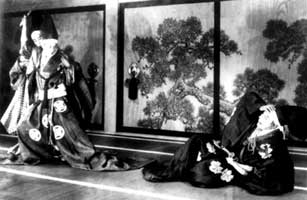 I've not been able to find that the 1934 film survives, but if any fragment of it does so, I'm sure Matsuda Film Archive will eventually make it available on cd-rom. I've not been able to find that the 1934 film survives, but if any fragment of it does so, I'm sure Matsuda Film Archive will eventually make it available on cd-rom.
Chiezo had already appeared in a version that does survive, from the silent era, Jitsuroku Chushingura (Chushingura: The True Story of the Forty-seven Loyal Samurai; aka, Chushingura: The True Story, Makino, 1928).
Two stagey stills from this version are reproduced near this paragraph, above. The film was directed by Shozo Makino, known as "the father of chambara." His son, Masahiro Makino, himself later a great samurai film director, has a small role in the silent movie.
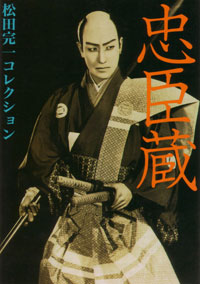 In 1928 a fire destroyed all the negatives for this epic silent film version, though it has modernly been imperfectly restored from the fragmentary preserved prints. In 1928 a fire destroyed all the negatives for this epic silent film version, though it has modernly been imperfectly restored from the fragmentary preserved prints.
What remains, at a bit over an hour, is available from Matsuda Films on cd-rom, in a big compilation Masterpieces of Japanese Silent Cinema. Matsuda Films also has it available separately on vhs tape.
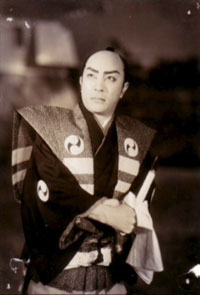 Denjiro Okochi is in multiple versions, not just Daisuke Ito's 1934. He again plays Oishi in Kajiro Yamamoto's two-part Chushingura zenpen & Chushingura kohen (Toho, 1939). The elegant Kazuo Hasegawa plays Lord Asano. Denjiro Okochi is in multiple versions, not just Daisuke Ito's 1934. He again plays Oishi in Kajiro Yamamoto's two-part Chushingura zenpen & Chushingura kohen (Toho, 1939). The elegant Kazuo Hasegawa plays Lord Asano.
I don't believe this version survives either in whole or in part. If any part of it ever does survive, I would dearly love to see even a fragment if that is all there is, as Yamamoto was an insightful director.
He has been credited with discovering Toshiro Mifune, recommending him to fellow director Senkichi Taniguchi for Snow Trail (Ginrei no hate, 1947), in which he plays one of a trio of bank robbers on the lam.
He then used Mifune later that same year in his own epic-length These Foolish Times aka New Age of Fools (Shin baka jidai) in which he plays a gang boss.
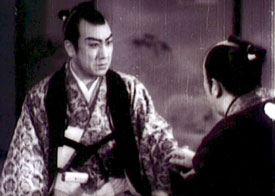 Yamamoto also took on as apprentice a young Akira Kurosawa, who was chief assistant director on the 1939 Chushingura project. Yamamoto also took on as apprentice a young Akira Kurosawa, who was chief assistant director on the 1939 Chushingura project.
Masahiro Makino would follow in his father's footsteps & co-direct (with Tomiyasu Ikeda) another version of the popular tale.
Chiezo Kataoka has a significant role in the two part Chushingura: Story of Heaven & Chushingura: Story of Earth (Chushingura: Ten no maki & Chushingura: Chi no maki, Nikkatsu, 1938). It was released on the tenth anniversary of Masahiro Makino's father Shozo's death.
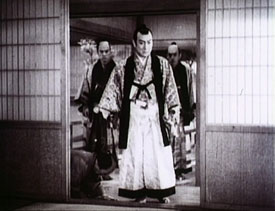 Chiezo was still looking physically good after ten years the leading man. Though his prettiness had worn off, there was as yet not much evidence of the jowly character-actor he became after the war. Chiezo was still looking physically good after ten years the leading man. Though his prettiness had worn off, there was as yet not much evidence of the jowly character-actor he became after the war.
Other big stars in this 1938 double-film include Tsumasaburo Bando & Ryunosuke Tsukigata. It's a stately dignified film, mannered & intense, marked by long static gazes of serious men, a talkie with silent film values in many scenes, in the best sense of quiet moments packed with meaning & feeling.
Tsumasaburo Bando was known as "Bantsuma" to his fans. He played the central role of Oishi who led the Brave 47, as shown in the sepia still.
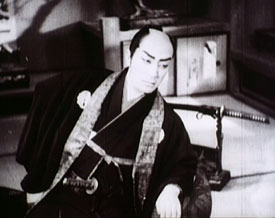 Chiezo played Sakon Tachibana who assisted in the Brave 47 even while no word was said directly addressing the matter of the great revenge. Chiezo played Sakon Tachibana who assisted in the Brave 47 even while no word was said directly addressing the matter of the great revenge.
Chiezo shares a very great & famous scene with Bantsuma; a still showing them together is placed near this paragraph. Both actors achieve incredible heights of emotive power.
Chiezo also appeared in the yakuza or modern gangster adaptation of the story, Gangyu Chushingura (Brave 47 Gangsters, Toei, 1963); & he'd play a moral, depressed, & semi-dissolute lancer in the "background" of the brave 47's doings, in Blooded Spear (Chiyari Muso, 1959).
copyright © by Paghat the Ratgirl
|


 Indeed this is the oldest surviving Japanese film bar none. The existing print has all but four of the original 42 scenes.
Indeed this is the oldest surviving Japanese film bar none. The existing print has all but four of the original 42 scenes. Reproduced here is a film still of Onoe in a sword posture, exceedingly attractive, in the title role of a lost film about the brave forty-seven from the same year as the surviving film,
Reproduced here is a film still of Onoe in a sword posture, exceedingly attractive, in the title role of a lost film about the brave forty-seven from the same year as the surviving film, 
 I've not been able to find that the 1934 film survives, but if any fragment of it does so, I'm sure Matsuda Film Archive will eventually make it available on cd-rom.
I've not been able to find that the 1934 film survives, but if any fragment of it does so, I'm sure Matsuda Film Archive will eventually make it available on cd-rom. In 1928 a fire destroyed all the negatives for this epic silent film version, though it has modernly been imperfectly restored from the fragmentary preserved prints.
In 1928 a fire destroyed all the negatives for this epic silent film version, though it has modernly been imperfectly restored from the fragmentary preserved prints.
 Yamamoto also took on as apprentice a young Akira Kurosawa, who was chief assistant director on the 1939 Chushingura project.
Yamamoto also took on as apprentice a young Akira Kurosawa, who was chief assistant director on the 1939 Chushingura project. Chiezo was still looking physically good after ten years the leading man. Though his prettiness had worn off, there was as yet not much evidence of the jowly character-actor he became after the war.
Chiezo was still looking physically good after ten years the leading man. Though his prettiness had worn off, there was as yet not much evidence of the jowly character-actor he became after the war. Chiezo played Sakon Tachibana who assisted in the Brave 47 even while no word was said directly addressing the matter of the great revenge.
Chiezo played Sakon Tachibana who assisted in the Brave 47 even while no word was said directly addressing the matter of the great revenge.